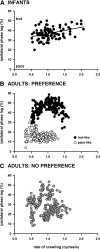Interlimb coordination in human crawling reveals similarities in development and neural control with quadrupeds
- PMID: 19036860
- PMCID: PMC2657078
- DOI: 10.1152/jn.91125.2008
Interlimb coordination in human crawling reveals similarities in development and neural control with quadrupeds
Abstract
The study of quadrupeds has furnished most of our understanding of mammalian locomotion. To allow a more direct comparison of coordination between the four limbs in humans and quadrupeds, we studied crawling in the human, a behavior that is part of normal human development and mechanically more similar to quadrupedal locomotion than is bipedal walking. Interlimb coordination during hands-and-knees crawling is compared between humans and quadrupeds and between human infants and adults. Mechanical factors were manipulated during crawling to understand the relative contributions of mechanics and neural control. Twenty-six infants and seven adults were studied. Video, force plate, and electrogoniometer data were collected. Belt speed of the treadmill, width of base, and limb length were manipulated in adults. Influences of unweighting and limb length were explored in infants. Infants tended to move diagonal limbs together (trot-like). Adults additionally moved ipsilateral limbs together (pace-like). At lower speeds, movements of the four limbs were more equally spaced in time, with no clear pairing of limbs. At higher speeds, running symmetrical gaits were never observed, although one adult galloped. Widening stance prevented adults from using the pace-like gait, whereas lengthening the hind limbs (hands-and-feet crawling) largely prevented the trot-like gait. Limb length and unweighting had no effect on coordination in infants. We conclude that human crawling shares features both with other primates and with nonprimate quadrupeds, suggesting similar underlying mechanisms. The greater restriction in coordination patterns used by infants suggests their nervous system has less flexibility.
Figures







References
-
- Adolph KE, Vereijken B, Denny MA. Learning to crawl. Child Dev 69: 1299–1312, 1998. - PubMed
-
- Akay T, McVea DA, Tachibana A, Pearson KG. Coordination of fore and hind leg stepping in cats on a transversely-split treadmill. Exp Brain Res 175: 211–222, 2006. - PubMed
-
- Babič J, Karčnik T, Bajd T. Stability analysis of four-point walking. Gait Posture 14: 56–60, 2001. - PubMed
-
- Bajd T, Ẑefran M, Kralj A. Timing and kinematics of quadrupedal walking pattern. Proc IEEE/RSJ Int Conf Intell Robots Systems, Pittsburgh, PA, 1995.
-
- Ballion B, Morin D, Viala D. Forelimb locomotor generators and quadrupedal locomotion in the neonatal rat. Eur J Neurosci 14: 1727–1738, 2001. - PubMed
Publication types
MeSH terms
LinkOut - more resources
Full Text Sources

